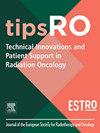核磁共振成像中腹部脂肪量化的可行性及对放射治疗运动管理中腹部加压效果的影响
Q1 Nursing
Technical Innovations and Patient Support in Radiation Oncology
Pub Date : 2023-12-19
DOI:10.1016/j.tipsro.2023.100232
引用次数: 0
摘要
利用磁共振成像(MRI)确定了脂肪对腹部癌症患者腹部压迫效果的影响。内脏和皮下脂肪在 T2W 三维核磁共振成像上进行了划定,压缩时的运动变化在二维电影核磁共振成像上进行了测量。16 名参与者的研究结果表明,脂肪百分比、体重指数 (BMI) 和运动变化之间没有相关性。体重指数中位数为 28.7(标准差,4.9)。压缩后的平均运动减少量为 7.8 毫米(IQR,5.0;P = 0.001)。虽然在脂肪、体重指数和压迫效果之间没有发现直接联系,但腹部压迫对于放疗计划中的运动管理仍然至关重要,并能提供剂量学优势。本文章由计算机程序翻译,如有差异,请以英文原文为准。
Feasibility of abdominal fat quantification on MRI and impact on effectiveness of abdominal compression for radiotherapy motion management
The impact of fat on abdominal compression effectiveness in abdominal cancers was determined using magnetic resonance imaging (MRI). Visceral and subcutaneous fat were delineated on T2W 3D MRI, and motion change with compression was measured on 2D cine MRI. Results from 16 participants showed no correlation between fat percentage, body mass index (BMI), and motion change. Median BMI was 28.7 (SD, 4.9). Mean motion reduction was 7.8 mm (IQR, 5.0; p = 0.001) with compression. While no direct link was found between fat, BMI, and compression effectiveness, abdominal compression remains crucial for motion management in radiotherapy planning, providing dosimetric benefits.
求助全文
通过发布文献求助,成功后即可免费获取论文全文。
去求助
来源期刊

Technical Innovations and Patient Support in Radiation Oncology
Nursing-Oncology (nursing)
CiteScore
4.10
自引率
0.00%
发文量
48
审稿时长
67 days
 求助内容:
求助内容: 应助结果提醒方式:
应助结果提醒方式:


